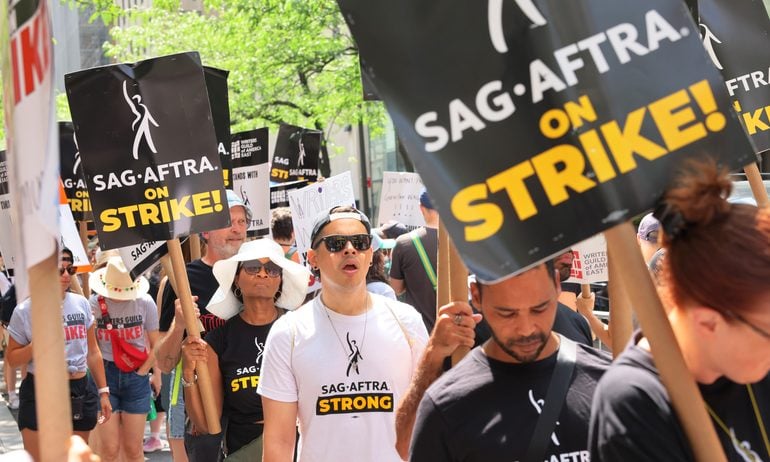What Is a Strike?
The economic hit to employers makes this a powerful tool for workers looking to effect change in their workplace.

Many, or all, of the products featured on this page are from our advertising partners who compensate us when you take certain actions on our website or click to take an action on their website. However, this does not influence our evaluations. Our opinions are our own. Here is a list of our partners and here's how we make money.
A strike is an action taken by a group of employees who stop working in an attempt to pressure their employer into meeting their demands. Workers strike over a wide array of issues, but the most common demands include higher wages, safer working conditions and better benefits.
A strike is a powerful tool for workers looking to effect change in their workplace. Halting production can impact a company’s bottom line and draw public attention to workers’ complaints.
For example, United Auto Workers went on strike this fall seeking pay raises and better benefits for retirees, among other demands. The strike against Ford, General Motors and Stellantis (a multinational conglomerate that includes Chrysler) lasted six weeks and ended Nov. 20.
Deals with the automakers known as the Big Three included numerous concessions on wages and other key issues including an historic 25% raise in base wages over four-and-a-half years.
The UAW strike interrupted car manufacturing, adding even more strain on an industry that’s been struggling with supply chain issues. According to an analysis by consulting firm Anderson Economic Group, the strike cost automakers more than $4.3 billion after six weeks. During that time, the analysis estimates total economic losses of more than $10.4 billion.
How a strike works
The National Labor Relations Act of 1935 gives U.S. employees the right to strike.
Deciding to strike
Workers decide to strike for a variety of reasons. In 2022, the top reason was pay, followed by health and safety issues and staffing, according to the Labor Action Tracker, an annual report on work stoppages by unionized and nonunionized workers compiled by researchers with the Cornell University ILR School.
News moves fast. Stay ahead of how it could impact your money.
Interest rates, inflation, natural disasters — get notified when breaking news could affect your finances, and get expert insights to help you plan your next move.

Often, strikes are organized by labor unions, which have the role of representing their members in contract negotiations with employers. For a union to go on strike, it has to have support from union members who cast secret ballots in a strike authorization vote. Voting to authorize a strike doesn’t guarantee a union will go on strike. Instead, authorizing a strike shows the employer on the other side of the bargaining table that the threat of a strike is credible because members have authorized union leaders to call for a strike.
The Screen Actors Guild and the American Federation of Television and Radio Artists (SAG-AFTRA), which represents 160,000 performers, authorized a strike in early June 2023. Then, on July 13, its national board held a second vote to launch the strike, which lasted until a new contract was ratified on Dec. 5.
Can you strike without a union?
U.S. workers don’t have to be part of a union to go on strike.
The Fight for $15 campaign is a high-profile example of nonunionized workers organizing a strike. In 2012, fast-food workers in New York walked off the job in protest of low wages and poor working conditions. That soon grew into a nationwide campaign to demand a $15-per-hour minimum wage. As it has grown, Fight for $15 has amassed an eclectic group of low-wage workers. The impact of a Fight for $15 strike held in November 2016 rippled across the service sector, with workers walking off the job at airports, restaurants, child care centers and other job sites.
What happens to a striker’s job?
Because striking is a legally protected action, workers have some job protections when they go on strike. How much protection depends on the purpose of the strike. The purpose of a strike can be categorized in a couple of ways:
Economic strikes include workers who go on strike over demands like higher wages, shorter hours and better working conditions. When workers strike for economic reasons, they can’t be fired by their employer, but they can be replaced. If an employer hires permanent replacements, strikers don’t automatically get their jobs back at the end of the strike. Instead, strikers are given the first chance to be rehired if a job opens with the employer.
The threat of being replaced during an economic strike is real. Since the 1980s, when the Reagan administration took a harder stance against organized labor, employers followed suit and more often have used or threatened to use their right to permanently replace workers. However, that isn’t without consequences. Researchers have noted that replacing striking workers can escalate tension and prevent a resolution of the strike.
Also, employers who hire permanent replacements could have their motives closely scrutinized. The National Labor Relations Board, which protects workers’ right to collective bargaining, issued a ruling in 2016 that said Piedmont Gardens, a care facility in Oakland, California, committed an unfair labor practice by replacing strikers because that action was motivated by a desire to punish strikers and avoid future strikes, which violates workers’ right to strike.
Unfair labor practice strikes include workers who go on strike because their employer broke the law. Common unfair labor practices by an employer include interfering with employees’ right to organize or join a union or refusing to bargain in good faith with a union. When workers strike over unfair labor practices, they can’t be fired and they can’t be permanently replaced. Employers can hire temporary replacements during an unfair labor practice strike, but once the strike ends, workers are entitled to have their jobs back.
However, there are some instances when a strike violates the law. When that happens, workers’ jobs aren't protected. Here are a few cases where the right to strike is limited:
Workers at health care institutions must give 10 days’ notice before going on strike.
Workers can’t go on strike to compel an employer to commit an unfair labor practice or to support an unfair labor practice committed by a union. For example, workers can’t use a strike to pressure an employer to fire someone who’s not paying union dues.
Even if their strike is legal, workers could lose their jobs if their behavior during the strike violates the law. For example, workers who strike can’t physically interfere with people attempting to work or threaten workers who aren't striking.
Being part of a union during a strike can add a layer of job protection. During a strike, when a union and employer reach an agreement on a new contract, it's common for the union to insist that all striking workers be reinstated to their original jobs. Knowing that condition would likely be part of the contract, employers are unlikely to hire permanent replacements for workers who strike.
Do workers get paid while on strike?
Workers are in a tough spot financially while on strike. They don’t collect a paycheck and, in most states, they don’t qualify for unemployment benefits, according to LawInfo, a legal services site owned by Thomson Reuters. One exception is in New York, where striking workers can collect unemployment if a strike goes longer than 14 days.
Unions typically manage a strike fund — a pot of money used to keep workers afloat during a strike. Union members may be entitled to a certain amount from the strike fund, depending on union rules.
Workers who receive medical benefits through their employer may lose coverage if their employer stops paying its share of their insurance premiums. Workers on strike can maintain coverage under COBRA — a federal law that requires employers to temporarily extend coverage after employment ends. But, in that case, striking workers are on the hook for their insurance premiums during a strike. Some unions can afford to help members cover these added costs.
How long do strikes usually last?
In 2022, the majority of strikes lasted less than five days, according to Cornell’s Labor Action Tracker. About a third of strikes lasted more than five days, including some that went on for more than a month.
That’s a drastic change from earlier decades. In 1979, which is the last year comprehensive work stoppage data is available from the Bureau of Labor Statistics (BLS), strikes lasted 32 days, on average. And half of strikes lasted more than 16 days.
The decline of strikes in the U.S.
Strike activity has declined dramatically in the U.S. in recent decades.
In 2022, U.S. workers were involved in 424 work stoppages, which included 417 strikes and seven lockouts, according to Cornell’s Labor Action Tracker.
A lockout is a work stoppage initiated by an employer. It prevents workers from returning to work until they agree to certain terms.
Compare that to 1979, when 4,827 work stoppages were recorded, according to BLS. That year, work stoppages involved 1.7 million workers. At the time, that was typical. BLS stopped tracking work stoppages involving fewer than 1,000 people in 1980, making 1979 the last year for which comprehensive data is available. But data going back to the 1930s shows it was normal for millions of U.S. workers to engage in thousands of strikes per year.
Strikes have declined because striking has become riskier. Since the 1980s, employers have been more forceful with unions by threatening to replace strikers. At the same time, union membership became less common as the U.S. economy shifted away from traditionally unionized industries like manufacturing. In 1983, about 20% of U.S. workers belonged to a union. Now, it’s just over 10%, according to BLS.
A resurgence of strikes in the U.S.
Despite the long-term decline, strikes appear to be having a resurgence now, according to Johnnie Kallas, a Ph.D. candidate in labor relations at the Cornell University ILR School. Kallas leads the Labor Action Tracker project.
Without comprehensive strike data from BLS, historical comparisons are tricky. But the Labor Action Tracker shows work stoppages increased by 52% from 2021 to 2022. The number of workers involved in work stoppages also increased last year, from 140,000 in 2021 to 224,000 in 2022.
In part, the uptick in strike activity stems from the pandemic, Kallas says. Since COVID-19 shut down businesses, maxed out supply chains and made in-person interactions riskier, there have been numerous examples of frontline workers organizing strikes over staffing issues and safety procedures. Those concerns spanned multiple fields, including education, health care, trucking and food service.
“The pandemic had a huge impact on labor activism and strikes in the United States,” Kallas says. “Not that these issues didn’t exist beforehand, but I think they were exacerbated.”
More generally, organized labor seems to be having a moment. The number of unionized workers in the U.S. is on the rise again, according to BLS. And workers at well-known companies like Starbucks, Google and Apple are leading unionization efforts. Meanwhile, unions enjoy high public approval ratings, according to an August 2023 Gallup Poll. The survey found that 67% of Americans approve of labor unions. That figure has climbed incrementally since 2009, when just 48% of Americans approved of labor unions.

